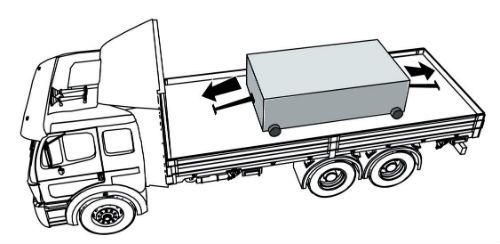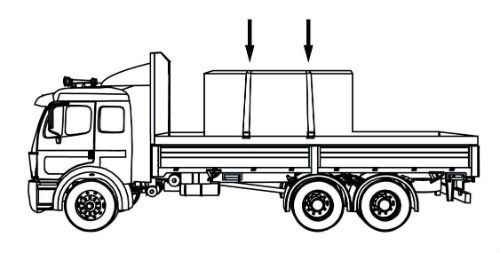CDL Practice Tests: Flatbed Cargo Securement
Choose A Section:
Go!When using tiedowns for securing cargo, what is the general rule regarding cargo length.
- 1 tiedown for every 5 ft, or part thereof.
- 2 tiedowns for every 10 ft, or part thereof.
- 1 tiedown for every 10 ft, or part thereof.
- 1 tiedown for every 15 ft, or part thereof.
When cargo is prevented from forward movement (for example, by the headboard, bulkhead, other cargo, or tiedown), secure the cargo according to the following requirements:

All Cargo:
1 tiedown for every 10 ft, or part thereof.
When using tiedowns to secure boulders, all of the following are requirements except:
- Tiedowns should be located in valleys or notches across the top of the boulder.
- Use only chain to secure large boulders.
- Tiedowns must be arranged to prevent sliding across the rock surface.
- Boulders must be loaded as far back towards the rear as possible.
Requirements

Use only chain to secure large boulders.
Tiedowns in direct contact with the boulder:

Should be located in valleys or notches across the top of the boulder
Must be arranged to prevent sliding across the rock surface.
What is bell pipe concrete?
- Concrete used to make bell pipe.
- Pipe whose flanged end is of larger diameter than its barrel.
- Pipe whose flanged end is of smaller diameter than its barrel.
- Pipe used to make concrete bells.
Bell Pipe Concrete:
Pipe whose flanged end is of larger diameter than its barrel.
To prevent rolling, how many points of contact are required, at minimum, for a boulder resting on a rounded or partially rounded side?
- 4
- 5
- 3
- 2
Requirements

If the flattest side of the boulder is rounded or partially rounded, place the boulder in a crib made of hardwood fixed to deck of vehicle.
Boulder should rest on both deck and timber, with at least 3 well-separated points of contact that prevent rolling in any direction.
When securing concrete pipe up to 45 inches loaded crosswise, tiedowns through the pipe must be:
- Wire.
- Chains
- Nylon rope.
- Straps.
Tiedown requirements
- Pipe may be secured individually or as a group.
- Tiedowns through the pipe must be chains.
- Front-to-back tiedowns may be chain or wire rope.
What is the Aggregate WLL of the securement system for a load secured with 7 tiedowns: 3 rated at WLL of 4,000 lbs, 2 at 6,500, and 1 at 8,000?
- 16,500 lbs
- 33,000 lbs
- 8,250 lbs
- 10,000 lbs
How do you calculate Aggregate Working Load Limit for tiedowns?
To calculate Aggregate Working Load limit, add together:
- 50% of the WLL of each end section of a tiedown that is attached to an anchor point.
- 50% of the WLL of each end section that is attached to the cargo
The aggregate WLL for logs loaded lengthwise must be at least:
- 1/2 the weight of the load.
- 1/6 the weight of the stack.
- 4,000 lbs
- 1/2 the weight of the stack.
Working load limit for longwood and shortwood loaded lengthwise
The aggregate working load limit for all tiedowns must be no less than 1/6 the weight of the stack of logs.
Note: This requirement is much less than the general requirement of an aggregate working load limit equal to 1/2 the weight of the load. This lowered requirement recognizes that the bunks/stakes help to prevent slippage.
What is the minimum amount of rearward force that a cargo securement system must withstand?
- 20% of cargo weight
- 100% of cargo weight
- 80% of cargo weight
- 50% of cargo weight
Each cargo securement system must be able to withstand a minimum amount of force in each direction.
- Forward Force = 80% of cargo weight when braking while driving straight ahead.
- Rearward Force = 50% of cargo weight when accelerating, shifting gears while climbing a hill, or braking in reverse.
- Sideways Force = 50% of cargo weight when turning, changing lanes, or braking while turning.
-
Upward Force = 20% of cargo weight when traveling over bumps in the road or cresting a hill.
- This requirement is satisfied when the cargo is "Fully Contained."
Option #3 for securing metal coils transported with eyes lengthwise includes all of the following except:
- Attaching at least one tiedown over the top of the coil near the front of the coil.
- Attaching at least two tiedowns through the center of the coil.
- Attaching at least one tiedown over the top of the coil near the rear of the coil.
- Using blocking or friction mats to prevent forward movement.
Tiedowns, Single Coil Option #3
Option #3 is the same as Options #1 and #2, except that the two tiedowns that attach through the eye of the coil are replaced with two tiedowns that pass over the front and the rear of the coil.

Attach at least one tiedown over the top of the coil near the front of the coil.
Attach at least one tiedown over the top of the coil near the rear of the coil.
Use blocking or friction mats to prevent forward movement.
The maximum distance from the rear allowed for attaching mechanisms used to secure roll-on/roll-off containers is:
- 3 feet
- 6 1/2 feet
- It doesn't matter.
- 2 feet

Attach mechanisms used to secure the rear end of a roll-on/roll-off or hook lift container no more than two meters (6.5 feet) from the rear of the container.
About The Flatbed Cargo Securement CDL Manual
Studying the flatbed cargo securement CDL manual is not a requirement for getting your CDL permit or license. It is required knowledge for flatbed drivers.
Some questions you should be able to answer for flatbed cargo securement:
- What is the minimum Working Load Limit of a tiedown used to secure logs?
- What is the minimum weight of a shipment of paper rolls that would require specific securement requirements?
- When securing concrete pipe over 45 inches loaded crosswise, which direction must the tiedowns on the front half of the load run?
- What is a cab shield?
- When securing concrete pipe over 45 inches loaded crosswise, which direction must the tiedowns on the rear half of the load run?
- What is a dunnage bag?
- Who is responsible for inspecting securing devices and cargo within the first 50 miles?
- How many tiedowns are required on a stack of shortwood loaded crosswise?
- What is the minimum working load limit of each tiedown used to secure crushed or flattened vehicles?
- Define 'bolster'
- What is a hook-lift container?
- When a tiedown is attached directly to the cargo, what is the ideal angle where it attached to the vehicle?
What is a securing device?
Any device specifically manufactured to attach or secure cargo to a vehicle or trailer:
- Synthetic Webbing
- Chain
- Wire rope
- Manila rope
- Synthetic rope
- Steel strapping
- Clamps and latches
- Blocking
- Front-end structure
- Grab hooks
- Binders
- Shackles
- Winches
- Stake pockets
- D-rings
- Webbing ratchet
- Bracing
- Friction mat
What is a tiedown?
A combination of securing devices that forms an assembly that:
- Attaches cargo to, or restrains cargo on a vehicle.
- Is attached to anchor point(s).

Some tiedowns are attached to the cargo and provide direct resistance to restrain the cargo from movement.

Some tie-downs pass over or through the cargo. They create a downward force that increases the effect of friction between the cargo and the deck. This friction restrains the cargo.
 Related Cargo Securement Terms That Every Driver Should Know:
Related Cargo Securement Terms That Every Driver Should Know:
-
Tiedown:
A combination of securing devices which form an assembly that attaches cargo to, or restrains cargo on, a vehicle or trailer, and is attached to anchor point(s).
-
Contained:
Cargo is contained if it fills a sided vehicle, and every article is in contact with or sufficiently close to a wall or other articles so that it cannot shift or tip if those other articles are also unable to shift or tip.
-
Blocking:
A structure, device, or another substantial article placed against or around an article to prevent horizontal movement of the article.
How should tiedowns be attached?
Tiedowns can be used in two ways:
-
Attached to the cargo:
- Tiedowns attached to the vehicle and attached to the cargo.
- Tiedowns attached to the vehicle, pass through or aroundan article of cargo, and then are attached to the vehicle again.
-
Pass over the cargo:
- Tiedowns attached to the vehicle, passed over the cargo, and then attached to the vehicle again.
Tiedown placement:

Place the tiedown as close as possible to the spacer.
Position the tiedowns as symetrically as possible over the length of the article.

Position the tiedowns to preserve the integrity of the article.







 TT On Facebook
TT On Facebook